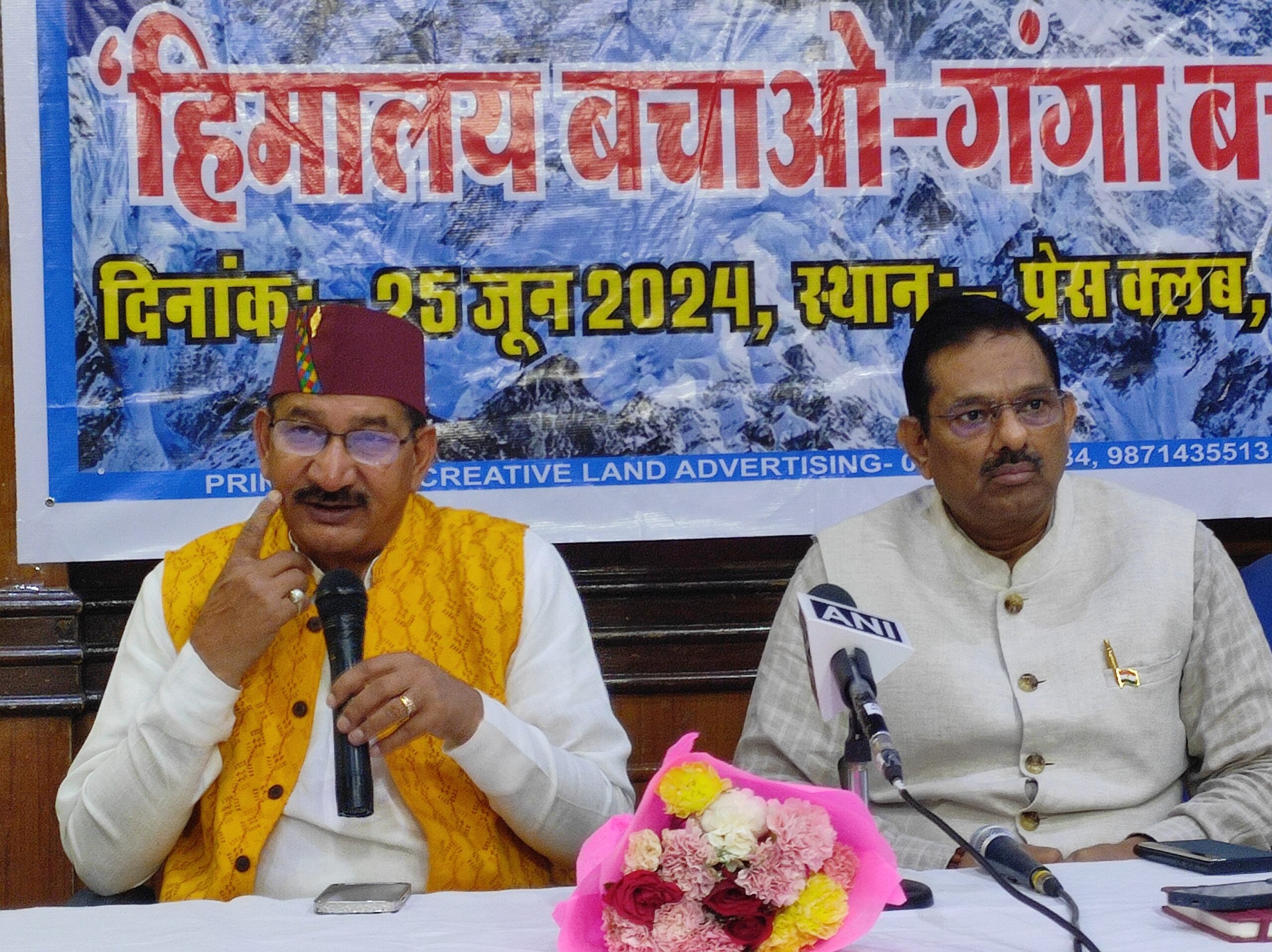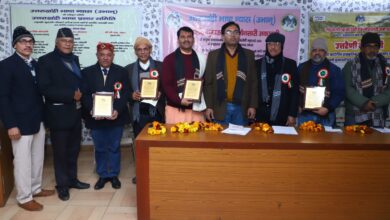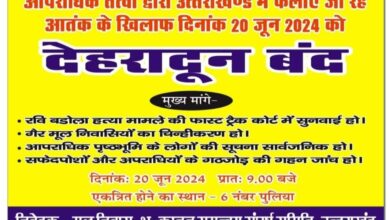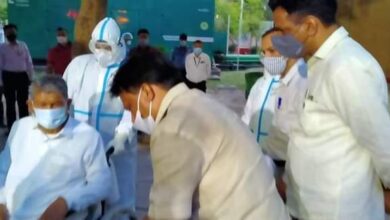FRUITFUL MEET HELD AT PRESS CLUB OF INDIA TO TO FIND WAYS AND MEANS TO AVERT SPEEDILY MELTING OF GAUMUKH GLACIAL IN UTTARAKHAND HIMALAYAS



SUNIL NEGI



Kishore Upadhyay, the lawmaker from Tehri Garhwal legislative constituency on Tuesday organised a press meet cum seminar at Press club of India, New Delhi under the topic ” Save Himalayas save Ganga”, attended by good number of people including journalists, writers, environmentalists and people concerned over the increasing global warming.
The basic concern of Kishore Upadhyay was about the speedily melting glaciers especially the Gaumukh glacier from where emanates the pious Ganges serving and protecting the entire humanity not only in India , Asia but globally.
The speakers expressed their serious concern over the increasing temperatures not only in the metropolises , cities and towns of the country but in the hills of Uttarakhand and Himachal Pradesh etc and subsequently glaciers melting rapidly and moving backwards i.e.26 kilometres.
According to Kishore Upadhyay, the main purpose of convening the seminar cum press conference at Press Club of India on Tuesday was to seriously think over this widespread and rapid increase in temperatures due to global warming and climate change , rapid melting of glaciers and future risk of Ganga depleting from the map of the country inviting disastrous consequences.
He expressed the dire need to convene a joint meeting of both houses of parliament on this pivotal issue of climate change and rapidly melting of glaciers including increasing footfalls in Uttarakhand and imbalanced development at the cost of environment degradation etc – leading to increasing temperatures and subsequently finding an incredible solution to these uncontrolled surge in environmental degradation, increasing forest fires, destruction of flora and fauna and human existence coming under grave threat.
The former Advisor in planning commission Avinash Mishra spoke on this pivotal issue at length on the rapid melting of glaciers , its severe consequences and the solutions thereof.

AVINASH MISHRA is former Adviser (Water & Land Resources, Environment, Forests & Climate Change ,Panchayat Raj Verticals ) of NITI Aayog (GOI). Working as Honorary Chairman of Water Audit Council.
He is having an experience of more than 30 Years of Water Resources sector & Environment sector . His educational qualifications are B.E. (CIVIL), M.Tech. (Water Resources) from IIT Delhi .
He has contributed in the National Policy Planning formulation, Action Plans of the country. Delivered Development Plans, Proposals of the State Governments relating to Major, Medium, Minor Irrigation, Flood Control, Drainage, Command Area Development, Watershed Development, Drinking Water Supply , Sanitation, Forests & Environment.
He is also credited for assisting the Plan Panel of the country in the Analysis and prioritization of various projects in terms of socio economic benefits and its impact, representing the Planning Commission thereafter NITI Aayog in the various technical advisory committees of the Irrigation & Water Supply Sector.
He has to his credit Initiating several schemes i.e. PMKSY, JJM, SVAMITVA Yojana , Atal Bhujal Yojana, Aquifer Mapping .
In addition to this he had been the Member of various Committee on Water Resources including the Committee of Bureau of Indian Standards.
A significant contributor in various reports and publication as below IITian Avinash Mishra is an invaluable asset for the nation in environment, forests, climate change and Panchayati Rajya etc. His reports are (1) Report of the Irrigation Task Force , (2) Report of the Ground Water Management and Ownership (3) 12th Plan Document of India relating to Water Resources Sector (4) Report of the High level Expert group on Water logging in Punjab, (5) Road map on Pradhan Mantri Krishi Sinchai Yojana, (6) Composite Water Management Index (7) Water Neutrality (8) Irrigation from Waste water in Urban and Peri Urban areas.(8) Manual on Water Audit for Built Environment .
Speaking at length on the degrading environment and ecology, including rapidly melting of glaciers in the Uttarakhand Himalayas, Avinash Mishra said that the time has come when we all have to tighten our belts and unify together to deal with this awful situation as ecological catastrophes especially melting of glaciers won’t affect the people of Uttarakhand or Himachal Pradesh separately or singularly but those living in Mumbai n Delhi etc leading a luxurious life styles will be equally impacted negatively n so will be those living worldwide.
He said according to the latest ISRO report about 27% of the identified Himalayan Glacial Lakes have significantly expanded since 1984 due to melting of glaciers . India has 130 such over expanded lakes out of the total expanded lakes. Of the 2,431 lakes, larger than 10 hectares were identified during 2016, 17 and about 676 lakes have notably expanded since 1984.
Though historically research reveals that glaciers have been retreating and thinning at an unprecedented rates since the industrial revolution of the 18 th century but after tremendous global warming starting from 1984 n now temperatures soaring abruptly n tremendously , the glacial melting has been very speedy , with Gaumukh Glaciar n others retracting back say 27 kilometres , expanding several glacial lakes that may burst anytime as happened in June 2013 creating havoc in Kedarnath n may be more dangerous than that.
On forest fires on massive scales destroying the flora and fauna , as is the case in Uttarakhand forests in every summer season having destroyed more than 15000 hectares of forest land n ten human kills etc this year – former advisor in “Niti Ayog ” Avinash Mishra said that forest fires are emitting substantial amount of green house gases n particulate matter into the atmosphere than assumed in the state climate targets. It plays a very damaging role to contribute in climate change by creating combustible environments such as shrub lands, grasslands n forests. These forest fires n climate change are the intertwined concepts . As vegetation burns, it releases the carbon stored within them, this this being the main reason why large scale forest fires release atmospheric carbon dioxide ( CO2) and hence are responsible for increasing the rate of climate change to a great extent said Avinash Mishra former Delhi IItian n advisor to Niti Ayog . He said : The forest ecology out of balance with environmental changes can lead to uncertainty and instability with forest fires highly negatively impacting our biodiversity , land degradation and climate change ultimately among other factors contributing tremendously in melting of glaciers.
Speaking on government initiatives Avinash Mishra said that lot is being done on the front of Namame Ganga covering 364 projects with a cost of 30863 crores including several other water treatment plants but there need to be consistent exercise at the governmental level to minimise and address displacement related to the adverse impacts of climate and environmental change which include support from all levels and effective actions to save n protect the mountains of the Himalayas.
Sustainable land management , carbon pricing and market mechanisms ,reforestation, sustainable transportation and energy efficiency should be executed with strong policy frameworks, technological advancements and individual actions to contribute massively to mitigating climate change and creating a sustainable future emphasised Avinash Mishra. This will only be possible, conducive and fruitful if it is at the national as well as at the global level said Avinash Mishra.






